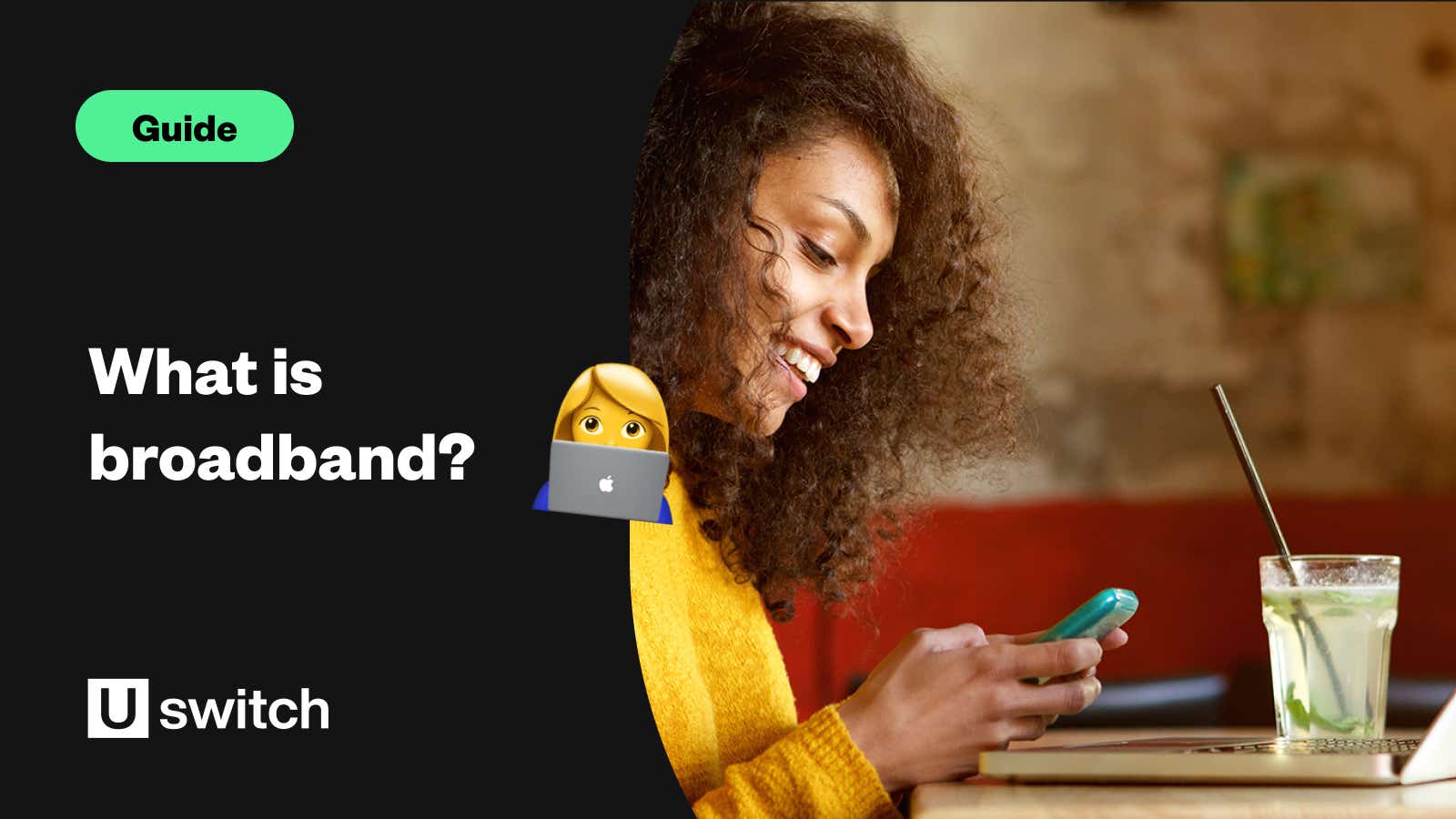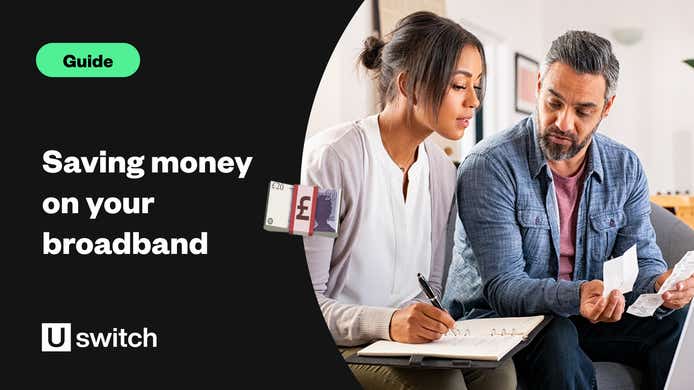Broadband is a high-speed internet connection that can grant you access to the full spectrum of online possibilities. In contrast to the sluggish dial-up connections of the past, broadband has revolutionised internet access, providing significantly faster speeds and enabling a broader range of online activities.
When first introduced, broadband used to literally mean the opposite of ‘narrowband’, which was the technology behind dial-up connections. But after it surpassed dial-up as the standard way to connect to the internet in the 2000s, 'broadband' has taken many different forms, and now refers to most types of internet connection.
Nowadays, it could mean anything from fixed-line home connections like copper ADSL or fibre-optic to 4G, 5G and even satellite broadband.
In the days of dial-up, you had to hang up the landline to use the internet. But with broadband, the frequencies on a telephone line could be split into channels, so you can use the phone on one channel and the internet on another.
For most of the last 20 years, UK broadband has mainly relied on BT phone lines, either fully or partially. But recently, there has been significant growth in other types too, such as full fibre broadband connections and 4G and 5G mobile broadband.
When did broadband start?
Broadband connections first started rolling out at the turn of the millennium. Once we reached the year 2000, internet service providers had figured out a way to ‘split’ the connection on your landline between the internet and your home phone.
By creating multiple channels for data to pass through all at once, a single cable could transmit separate data at the same time. This meant that people no longer had to rely on dial-up, where you couldn’t use your home phone if you were connected to the internet, and vice-versa. So broadband allowed households to use both services simultaneously.
This said, it took quite a while for broadband to roll out across the whole country, so dial-up connections were still very much a thing until the end of the 2000s. We’re seeing a similar pattern today with full fibre broadband, which removes the need for a landline completely and offers much faster internet speeds.
For a full timeline of the internet from when its inception to the modern day, read our history of the internet guide.

How does a broadband connection work?
Technically, a broadband connection is what plugs into your home router via the broadband socket installed on your property. The wireless connection from your router to all of your devices is Wi-Fi. But if we’re strictly talking about how the internet gets to your home, here’s a quick rundown.
It all starts with internet data — essential information for devices to do anything online, which could be in the form of a website, a movie, a video call, a video game, social media content, etc.
Internet data is hosted and shared by a huge batch of servers at one of many locations around the country.
Some broadband providers host networks of cables that allow the data to travel to our homes. This is usually through copper or fibre-optic wires, but it can also be transmitted via mobile internet data (such as 4G or 5G) or even satellite signals.
That network then connects to our homes through a wireless router, which we can connect to wirelessly with our devices to access access the internet data and let you do what you want online.
How can I get broadband?
If you haven’t had a broadband connection before, the process of getting one is quite straightforward. But before deciding among the many options out there, you need to know:
What kind of broadband do you need
What your budget is
What kind of broadband is available at your home
Firstly, it’s important to make sure that the home you’re living in already has a broadband connection installed. Luckily, if you already have a landline installed at your home, it will be very easy to get broadband too.
Most broadband connections use a landline to get to our homes. So getting online could just be a case of contacting your home phone provider, and asking them to upgrade you to a broadband and home phone plan.
If you don’t have a landline installed at your property, or you’d like to explore different providers to your landline supplier, our list of broadband providers will show you a range of options and prices to choose from.
Just keep in mind that it takes at least two weeks for a brand-new broadband connection to be installed because you’d need to book an engineer visit to set it up and give you your wireless router.
Check out our guide on wireless routers for more details.
When you’re searching, make sure any provider you look into is available at your property first - you can do this by putting your address in the search box when you click on a provider.
You also need to consider what kind of broadband is best for your household. If you live alone or just with a partner, and you don’t expect to be using the internet much, a slower (and cheaper) deal would suit you. But if you have multiple people all wanting to connect at the same time, a slightly faster connection might be needed.
Our broadband speeds guide details what speed you should go for, depending on your household size, internet use and budget.
What do I get with a broadband connection?
When you purchase a broadband deal, you will enter a contract with the provider that supplies the connection, often for a fixed term period. This period usually lasts between 12 months and 24 months, but some contracts are monthly rolling too.
By signing up for a contract, you agree to pay the monthly amount that would have been displayed when you chose your broadband offer. However, providers must also now display whether they will increase their prices each year, so keep a keen eye out for that too.
You should also expect a price increase once your fixed contract term ends. So make sure to keep note of your contract end date and look around for a new deal before you’re moved onto a more expensive rate.
When your new broadband connection starts, whether an engineer installs it or not, you will need to set up a wireless router. This plugs into both a mains socket and your broadband receiver, and it’ll help you access the internet on all of your devices that have a Wi-Fi connection.
This includes all of the common internet-connected devices like smartphones, computers, smart TVs and smart speakers. All you need to do is find the router’s name on your device and then put in the password displayed on the router to get online.
Make sure to keep your router in an open, central part of the home so you can make the most of its signal. Objects, especially metal ones, can block the Wi-Fi, so it’s best to avoid hiding it away in a cupboard or behind the TV.
Think you’re ready for broadband? Take a look at our more detailed guide on how to switch broadband.
Now we’ve shown you how to get broadband, read on to learn more about what broadband is, and find out the different ways it can get to your home.
Types of broadband connection
There are a few ways in which broadband is delivered to our homes in the UK:
Copper ADSL
Phone lines, split into multiple different ‘channels’ to allow for both landline andbroadband use, connecting straight from the broadband exchange to your home. Available to 99% of the UK. Average internet speeds of 10Mbps.
Part-fibre (fibre-to-the-cabinet)
Fibre-optic cables use pulses of light to transmit data, connecting to a local cabinet on your street, with copper phone lines making the rest of the journey to your home. Available to 98% of the UK. Internet speeds range from 30-70Mbps.
Cable broadband (Virgin Media)
Fibre-optic cables connecting to a local cabinet on your street, with Virgin Media’s coaxial cables making the rest of the journey to your home. Currently available to about 60% of the UK, but growing. Internet speeds range from 100Mbps-1Gbps.
Full fibre (fibre-to-the-premises)
Fibre-optic cables connecting straight from the broadband exchange to your home. Currently available to two-thirds of the UK, but growing. Internet speeds range from 50Mbps to beyond 1Gbps.
Mobile broadband
A special router with a SIM card that connects to 4G or 5G signals in the area and sends that to your devices in the form of Wi-Fi. Average 4G internet speeds are 24Mbps, 5G speeds range from 100-300Mbps.
Satellite broadband
Satellites beam an internet signal to a dish installed at your property, which is plugged into a router in your home. Starlink satellite internet speeds often reach around 300Mbps.
Read our more detailed guide on the different types of broadband available in the UK.
What's the difference between fibre broadband and copper broadband?
The main difference between standard copper (ADSL) broadband and fibre-optic broadband is the internet speed it provides. Fibre-optic cables transmit much more data in a given period than the older, copper-based phone lines used for ADSL broadband.
Most copper ADSL broadband services will offer average download speeds of around 10Mbps — though due to the dated infrastructure it works on and other variables it can be quite inconsistent.
Whether it's the particular line you're connected to, how far you are from your street cabinet or how many people in your neighbourhood are using the internet all at once, many factors can affect the ADSL speed you receive. So in reality, you could receive anything from around 16Mbps to less than 1Mbps, depending on your circumstances.
Most fibre broadband services, on the other hand, start at around 30Mbps — some three times faster. They also use more robust technology that allows for a faster, more consistent connection that doesn't change speed so unexpectedly.
It's also worth noting that fibre broadband packages at their lowest speeds are often the same price, sometimes even cheaper, than many ADSL prices nowadays — especially if you're currently paying out-of-contract prices. So that means you could get a much faster Uswitch broadband deal for even less money
Fibre broadband deals are offered at a range of speeds up to and beyond 1Gbps (that's 1000Mbps), depending on the type of fibre connection you can get. That's about 100 times faster than copper-based broadband, and it would future-proof your home for decades.
We call fibre broadband 'faster' because downloads are completed in a much quicker time, meaning webpages, images and videos load a lot sooner.
But it also means the quality of what you do online significantly improves, because it allows for more detail in the things you watch and listen to online. 4K video, for example, is made possible with superfast fibre speeds.
What can affect broadband speeds?
While there are many factors to consider with a broadband deal, one of the most important is the speed of the internet connection.
When it comes to internet connection speeds, you need to remember that speeds can vary and there are factors that can affect them. Broadband providers advertise "average" speeds that must be available to 50% of customers — meaning you've got a 50/50 chance of getting higher or lower speeds than what's advertised. But most of the time, you won't be getting these speeds due to things largely out of your control.
One major influence on speeds is the internet traffic levels in your local area. Since your connection will be shared with your neighbours on the same local network, connections may slow down during peak usage times.
If you have a copper connection, the distance between the telephone exchange (or local cabinet) and your house coupled with the quality of the cables used will also determine the speeds you can actually receive.
Halogen lamps, electrical dimmer switches, stereo or computer speakers, fairy lights, TVs, monitors, and AC power cords are all recognised sources of potential interference for routers.
If you can, maintain a considerable distance between your router and other electrical devices, as well as those emitting wireless signals, such as cordless phones and baby monitors. Place your router on a table or shelf, avoiding the floor, and ensure it remains powered on at all times.
You can use our broadband speed tool to see how fast your current connection is within your home.
Take a broadband speed test
Run a broadband speed test to find out what speed you're currently getting, and what else could be available to you.
Wi-Fi vs wired broadband
The final part of your broadband connection is achieved by connecting your devices to your router. This can be done either through Wi-Fi, or with a wired ethernet connection.
Wi-Fi is by far the most popular way to connect your devices to the web at home. It simply describes wireless internet, so the majority of your devices — be they smartphones, laptops, smart TVs or streaming sticks — will use Wi-Fi to get online. If your device is Wi-Fi compatible, you can get online by searching for your router’s name on your device’s list of available connections, and then putting in your router’s password (which you can find on the router itself).
Most routers alone can provide a decent Wi-Fi signal for the whole property. But to make the most out of your router make sure you place it in a clear, central part of the home. If you’re still struggling to connect in certain rooms or you live in a larger house, you might need a Wi-Fi extender.
Wired internet connections are much simpler to set up. All you need to do is plug one end of an ethernet cable into your router, and the other end into your compatible device. However, they’re only practical for one or two of your devices at most, and you’ll either need an ethernet port on your device or a relevant USB ethernet adapter.
Wired internet connections supply faster and more reliable internet speeds than Wi-Fi, but only if you’re willing to run a cable to it. That’s why they’re only suitable for large, fixed devices like desktop PCs or game consoles.
Nowadays, it’s likely that you and the rest of your household use multiple internet-connected devices at the same time. And even if you don’t use that many devices, it’s rare that many of them will have a wired internet port either. So in these cases, it’s far easier and more convenient to rely on Wi-Fi connections to your router rather than wired ethernet ones.
Check out our broadband-only deals page to find the best deal for you.
Browse our range of broadband-only deals
Choose between dozens of broadband deals on Uswitch.
Which broadband is best for me?
We've got a few pages you might want to check out to get started on your search, including:
Broadband deals — For those of you just getting started with the internet, you'll want an easy-to-install broadband package that offers fantastic customer care. Our main broadband page has a wide range of options for many different households' needs.
Business broadband deals — Businesses have different needs than consumers, and online business broadband packages are tailored for these needs, with essential extras like fixed/static IPs, email addresses, added security software and online storage space.
Mobile broadband deals — If you're often on the move and need access to the internet, a 4G or 5G mobile internet dongle is your best bet because it gives you broadband access wherever you are, as long as there's mobile network coverage.
Compare our best broadband deals
Search on Uswitch to find the right broadband package for you.




